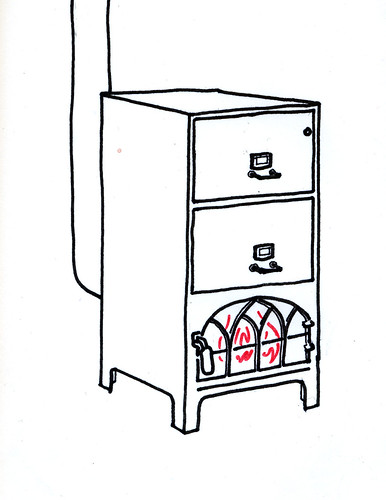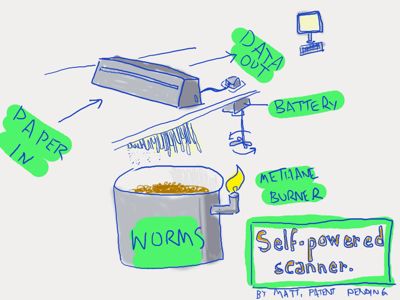Sometimes, it’s worth joining the dots between a few things you find. In this case, that was this image of a breadboard that dumps its crumbs onto a birdfeeder.

(The original image isn’t available at the moment, http://curroclaret.es having been temporarily taken offline due to excess bandwidth; I’ll link to it in due course.)
It’s both a piece of design and a visual joke: it connects two ideas (birds eat crumbs; breadboards collect crumbs) in the shortest possible distance. The entire rationale, the entire concept behind the design is laid flesh. Is it a product, a thing that makes sense in the world? Not really. The realities of kitchen design start to impinge if you think about it too long. Instead, it’s perhaps best to look at it and smile; if there’s something to be learned from it, it’s perhaps that two ideas really be connected as simply as with a bent piece of tubing.
The birdfeeder made me think a little about other examples of fantastical design, both real and imaginary. I’m not sure I’m anywhere near finding a deep interconnected thread between these, but I think as a juxtaposition of images, they all tie nicely together. In the meantime, here’s where the birddfeeder lead me.
Coincidentally, it made for a nice comparison to a recent post from friend of S&W Rod Mclaren, where he posits the idea for a combined filing cabinet and stove:

It also reminded me of a presentation of Matt’s about some of his favourite science fiction and the ideas therein, and, specifically, this slide:

There’s obviously a historical precedent for this kind of fantastic design and thought – practical ideas realised in somewhat absurd means – such as Heath Robinson’s gusset tightener:

or, if you’re American, the fantastic contraptions of Rube Goldberg:

Fantastical, outlandish design somewhat comes to a head in the work of Tim Hunkin, who somehow manages to balance a delightful sense of the absurd with solid, realistic technical skill; he’s only interested in the working and the real, and yet his sense of the absurd is at least as well refined as Heath Robinson’s.
What do all these things have in common? They explore the value of the absurd, be it absurd simplicity – as in the birdfeeder – or absurd complexity – as in Heath Robinson’s complex series of magnets and pulleys. What value does this kind of sketching, or thinking-out-loud, have for the practicing designer? I’m not entirely sure – after all, I am not a “practicing designer” myself. They remind me a little of Matt Ward’s sketching technique (which Jack discussed in his talk about Olinda): starting at extremes, and slowly iterating towards realism (and complexity). The birdfeeder, the filing cabinet, the shredder, all act a little like another form of “physical Powerpoint”: they may not be realistic, but they are highly expressive. And maybe that’s the value of this kind of design. Once the aims or thinking behind an artefact have been explained clearly, and succinctly – no matter how absurd – then it’s possible to iterate towards realism, towards a more sensible and sensical design.
2 Comments and Trackbacks
1. Mark Cridge said on 16 March 2009...
What a lovely post. It reminds of the first thing that was drummed into me when I studied Architecture, that the process was more important than the product.
If you wish to create work, objects, buildings, services whatever that rise above the humdrum or come up with answers to intractable impossible problems then clearly you’re going to need to start from a different place, and work towards a solution in a different way.
A standard design process will lead to exactly what you expect, a fantastical design process will lead to places you can’t even imagine yet.
2. Sugar Web Design said on 24 March 2009...
Love this article, just had to tweet it. I love that image of the breadboard. To me its like a visual definition of thinking outside the box. Brilliant, thanks. Dave.